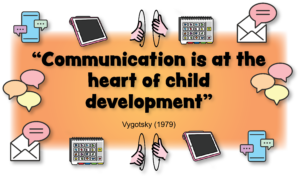Kindy Uplift Program and Children’s key word signing (KWS)

Are you a kindergarten that received Kindy Uplift funding?
Exciting news!
Your kindergarten now has the opportunity to utilise your Kindy Uplift funding to introduce Children’s key word signing into your service. We have specifically designed a comprehensive Children’s key word signing pack tailored for kindergartens and early childhood education and care settings, aligning with the priority areas of the Kindy Uplift program.
If you’ve come across this page through a search engine, you may be unfamiliar with Children’s key word signing and its significance for your kindergarten, as well as how it aligns with the Kindy Uplift program’s priority areas. In this article, we will cover the following topics:
- What is Children’s key word signing?
- How Children’s key word signing and our pack align with the Kindy Uplift Program’s priority areas.
- What is included in our Children’s key word signing pack?
Alternatively, you can download our brochure here:

What is key word signing (KWS)?
Key word signing, previously known as MAKATON, involves the use of manual signs, facial expressions, and natural gestures alongside spoken words to enhance communication for individuals who are pre-verbal or have communication difficulties. It is one of the most widely employed strategies for those who cannot rely solely on speech to communicate.
In Australia, the signs used in key word signing are kindly borrowed from Australian sign language (Auslan), although it differs significantly from Auslan as signs are used in conjunction with speech, with only the key words being signed. For more information on key word sign, click here.
Children’s key word signing is essentially the same as key word sign (KWS), with the distinction being that we exclusively develop resources, services, and training materials for children and those who work with children.
Furthermore, while key word signing was initially developed for individuals with communication difficulties and their communication partners, our goal is for Children’s key word signing to be embraced wherever children are present, offering all children an alternative means of communication.
It is an excellent tool for all children and an excellent use of your Kindy Uplift funding.
Kindy Uplift Priority Areas
In April 2022 more than 400 Queensland kindergartens received funding as part of the Kindy uplift pilot to improve early learning outcomes.1 The Kindy Uplift grants have 5 priority areas namely:
- social and emotional capability
- physicality
- thinking and responding
- oral language and communication
- access and inclusion.1
Children’s key word signing meets the criteria for all 5 priority areas.
The evidence based benefits of Children’s key word signing and how it they meet the Kindy Uplift priority areas are set out below.

Children feel safe, secure and confident in themselves and the learning environment, enabling them to take risks and make decisions. Children have the skills to sustain engagement in learning, manage emotions and connect positively with peers and significant adults.
Using Children’s Key Word Sign in your early childhood education and care setting is an effective way to support the social and emotional capability of children. It aligns with the Kindy Uplift grant’s priority on enhancing social and emotional skills.
Research has shown that incorporating Children’s Key Word Sign fosters strong attachments between children and educators, creating a safe and secure learning environment where children feel confident to take risks and make decisions.
Studies have indicated that educators who utilise Children’s Key Word Sign are more responsive to preverbal children, showing increased warmth, affection, and responsiveness to their needs.2
This approach enhances bonding between carers and children, leading to higher self-esteem and a stronger appreciation for the child’s autonomy and desires.3
Furthermore, educators who use Children’s Key Word Sign encourage more independent actions, empowering children to develop their skills and make choices.4
Implementing Children’s Key Word Sign (KWS) in your early childhood education and care setting enables children to communicate their feelings and request emotional support from an early age.
Toddlers have demonstrated the ability to initiate conversations about their emotions through sign language, promoting open communication and emotional well-being. Infants have also shown attempts at emotional regulation through sign, such as seeking comfort, indicating preferences during routines, and signalling for parental attention. 5 to 8

Children demonstrate coordination, strength, gross and fine motor skills in a range of learning situations. Children are confident to make use of the learning environment to support their physical wellbeing.
By incorporating signing into your Kindergarten curriculum, you provide children with a valuable opportunity to engage in what researchers refer to as “hand babbling.” Just as vocal babbling plays a crucial role in language development, hand babbling using sign language involves the same essential components necessary for linguistic growth, as highlighted by Petitto8. Through this process, infants and children focus their attention on their hands, their movements, and the various handshapes they can produce.
The impact of signing on children’s development goes beyond communication skills. Numerous studies have shown that infants and toddlers exposed to signing demonstrate improved hand-eye coordination9. The act of mimicking hand movements and learning sign language enhances their motor skills and coordination, providing a strong foundation for physical development. Additionally, these children exhibit significant improvements in fine motor development, showcasing their increased dexterity and control compared to their non-signing counterparts.10
By incorporating signing into your Kindergarten program, you empower children to explore and engage with their hands in a meaningful way. This active involvement not only enhances their physical abilities but also supports their overall cognitive and linguistic development. Sign language becomes a tool through which children can express themselves, develop coordination, and further their fine motor skills, setting them up for success in various aspects of their lives.

Children take in verbal and non-verbal stimuli and process this information to make meaning linked to their current knowledge and experience. Children demonstrate their understanding and respond in a variety of culturally appropriate ways.
Children’s key word signing ensures that the children at your kindergarten are exposed to both verbal and non-verbal stimuli. The use of signs often make it easier to associate words, signs and concrete objects assisting with their comprehension and understanding of the world. Further, evidence has shown that signing in bi-lingual families, and when learning a second language significantly improves learning of the second language.11 Therefore signing heavily assists the children in linking verbal and non-verbal stimuli to their current knowledge and experience.

Children express their thoughts, feelings and emotions for a range of purposes and can make themselves understood through verbal, non-verbal or augmentative technologies. Children seek to understand and listen to others and make meaning by exploring texts.
Children’s key word signing (KWS) ensure that children are able to express themselves from a very early age, if babies are introduced to sign they are often able to sign back from 8 – 10 months. Further, with an estimated 1 in 6 children12 having a language delay it ensures that the children at your kindergarten can express their thoughts, feelings and emotions through sign before they are verbal.
Research into baby signing has also focused on language production, mainly prompted by concern that baby sign may delay speech due to babies being able to communicate through sign. However, it was actually discovered in a longitudinal study that infants who were taught baby signs had significantly better receptive language (understanding of what was being said to them) and expressive language (being able to speak to express themselves) than non-signing infants.13 Signing babies also met their word-count milestones earlier, 14 and several other studies repeated the findings that infants and toddlers exposed to signing and speech frequently used spoken language before their peers exposed only to spoken language.15
There are many reasons for this but the reasons put forward by researchers have been that when babies sign it encourages more and varied communication and more word labels being used by caregivers in response to signs,16 and the use of signs for only key words assists in segmenting words from each other in running speech, which in turn helps build up their vocabulary which is important for the acquisition of language.
Similarly to baby signing, Key Word Signing was found to “facilitate early communication, increase vocabularies and facilitated shared communication.”17 A study by Leech and Cress found that the most effective way for a child to produce target words was “through routine and play structure combined with access to AAC [Alternative and Augmentative Communication].“18
Infants that have been seen to gesture earlier, including manual pointing, or more frequently have been found to have larger vocabularies than there peers, therefore it is apparent that when an Educator encourages signs with children it is likely that the numbers of gestures of the children will increase and may assist them in their expressive communication long term.19
Finally, our Children’s key word signing (KWS) pack for Early Learning Services also provides a story book with signs (Sunny Bear’s Messy Day), this is designed to assist the children at the kindergarten understand the meaning of the text and assist them in association of the signs, written words and visuals within the book.

The service and educators are ready to support all children and families so they feel welcome, engaged and culturally safe. Inclusive practices are embedded in the service and support all children’s active participation in the kindergarten program. The service and other partners provide supportive and responsive transition pathways for children and families across early years settings and work collaboratively to support all children’s learning, wellbeing and development.
By incorporating Children’s Key Word Signing (KWS) into your kindergarten, you can create an environment that fully embraces non-verbal / non-speaking children, eliminating any potential stigma they might face elsewhere. Children’s Key Word Signing is particularly beneficial for neurodiverse individuals, such as those with autism, Down’s syndrome, apraxia or developmental language disorder (DLD). However, it’s important to recognise that limiting signing to only those who require it for communication severely restricts its potential which is why our children’s key word sign packages teaches you how to use key word sign with all children.
Children’s Key Word Signing serves as an unaided communication tool. Extensive research indicates that when Key Word Signing or other Alternative and Augmentative Communication (AAC) tools are limited to non-verbal / non-speaking individuals and a select few communication partners, it often leads to stigmatisation and widespread exclusion.21 By incorporating Children’s Key Word Signing (KWS) into your Early Learning service, you take a significant step towards fostering inclusivity for all children. This ensures that even non-verbal / non-speaking children can enjoy meaningful interactions with a diverse range of peers and educators.
For a non-verbal/non-speaking child, the ability to communicate effectively significantly influences their willingness to engage and play with others. By encouraging all educators and children to utilise multi-modal communication methods, you eliminate any potential stigma and empower the child to feel confident about joining in with their peers. As a result, they become an active participant in the kindergarten program, contributing to their overall development and growth.
Choosing to implement Sunshine Sign and Sing’s comprehensive kindy package using your Kindy Uplift funding is the most effective way to ensure the successful integration of Children’s Key Word Signing into your kindergarten.
Our package provides the necessary resources, training, and ongoing support to help your educators seamlessly incorporate Key Word Signing into daily activities and interactions. With Sunshine Sign and Sing, you can be confident that you are making the best use of your funding to create an inclusive and empowering environment for all children in your care.

Our Children’s key word signing (KWS) Kindy Uplift Program pack includes everything you need to integrate Children’s key word signing into your Kindergarten. Research has found that in order for key word signing (KWS) to succeed you need a ‘signing environment,’ this includes:
- Training for communication partners
- Selecting functional signing vocabulary
- Access to resources and support
Therefore, our pack has been designed to ensure your kindergarten will have an immersive signing environment. The pack includes:
Children’s Key word Signing Professional Training
This professional training is for up to 10 educators and includes:

Professional Training Part 1 includes:
- What is Children’s key word sign?
- History of Children’s key word sign
- How to sign
- Types of signs
- Benefits of Children’s key word sign
- How children learn to sign expressively
- What first signs look likes
- Implementing it naturally into your Kindergarten
- Barriers to success
- Teaching of over 40 signs suitable for your Kindergarten
Approximately 1 hour 30 minutes
On completion participants receive a hard copy attendance certificate
All Training is online (live) or in person (travel costs extra)
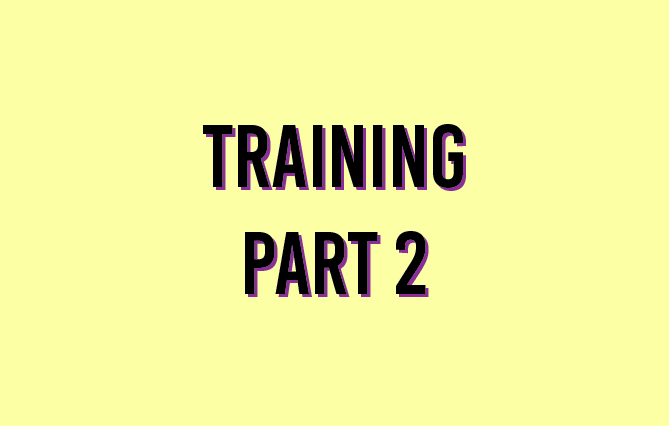
Professional Training Part 2 includes:
- Customised to your service including refresher of signs
- Teaching signs to any welcome, goodbye or pack away songs
- Overcoming obstacles discussion
- Core key word signs
- Fringe key word signs (Toys and play signs)
- Feelings key word signs
- Colour key word signs
Approximately 1 hour 30 minutes
Ongoing Children’s key word signing support
To ensure you all feel confident using Children’s key word sign we will complete follow ups either in person, video call or telephone to answer any questions, overcome any issues and assist with any Children’s key word signing needs..
These are undertaken at 3 and 6 months after the initial training.
Physical Resources
These physical resources were designed for early learning settings and include:
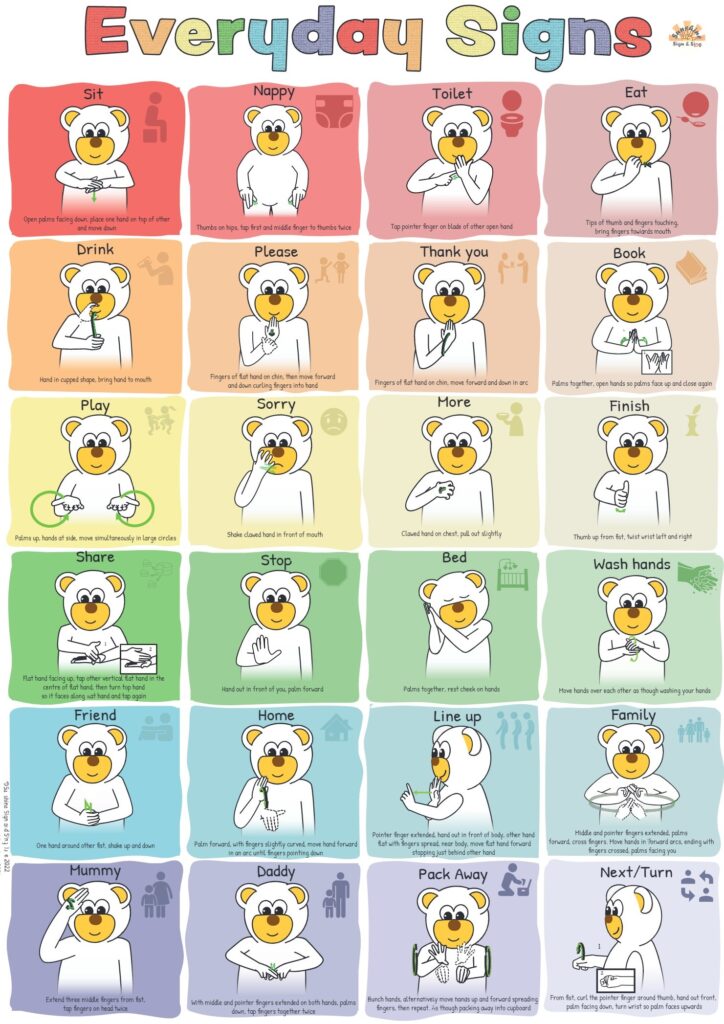
Kindergarten A2 key word sign poster
A2 Poster with 24 key word signs designed for Early Learning Services.
The key word signs include:
Sit, Nappy, Toilet, Eat, Drink, Please, Thank you, Book, Play,
Sorry, More, Finish, Share, Sleep, Wash Hands, Friend, Home,
Line Up, Family, Mummy, Daddy, Pack Away, Next / Turn

A6 Kindergarten Tearproof Flashcards
24 Flashcards that match the A2 key word sign kindergarten poster. These are perfect for group time and learning a sign of the week. Provides pictures as well as signs to provide another visual cue for the children. The material for the cards are wipeable, waterproof and tear proof on a hinged ring for ease of use.
Contains the QR code to take you to the online video tutorials.
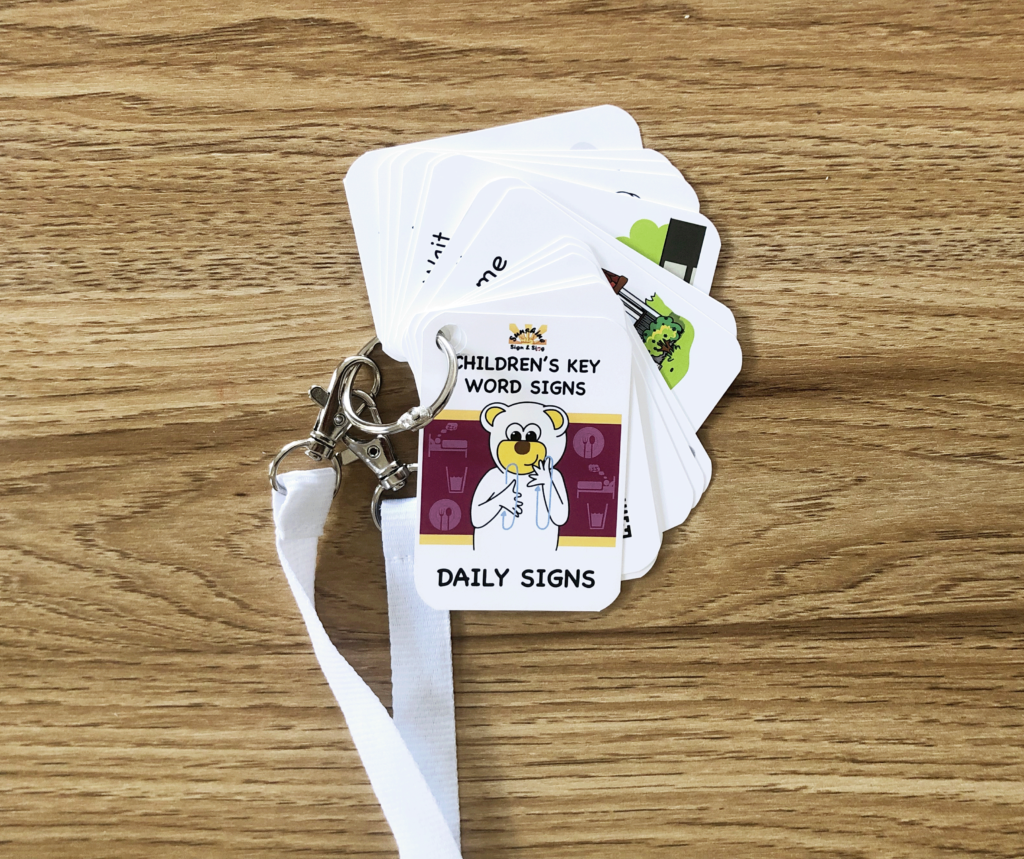
A8 Educators Key Word Sign Lanyard Cards
Each of the 10 educators receive the lanyard cards in the pack.
The cards contain 15 key word signs for use in the kindergarten. Provides pictures as well as signs to provide another visual cue for the children. The key word signs include:
eat, drink, turn, help, stop, wait, play, home, sit, share, sleep, finish, good, friend and toilet.
Contains the QR code to take you to the online video tutorials.
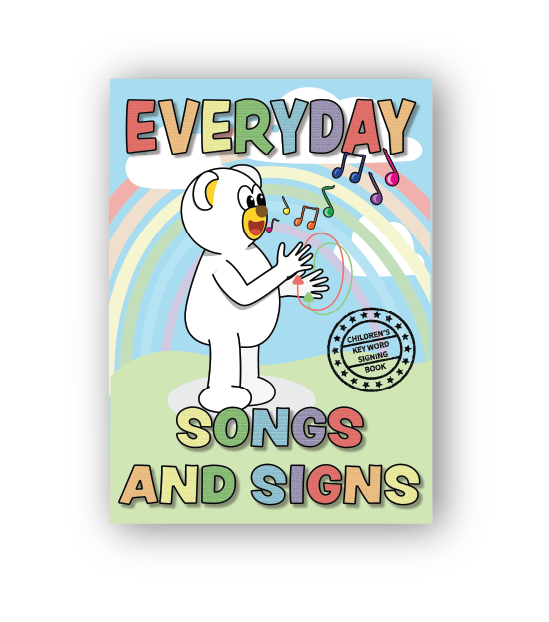
A4 Song and Key Word Sign Book
This A4 book contains 10 songs including nursery rhymes and other everyday songs. Each page has lyrics on one side and key word signs on the other.
The more you practice the more key word signs you and the children can add to each song. It also contains the QR code to take you to the online video tutorials and separate sing and sign videos.
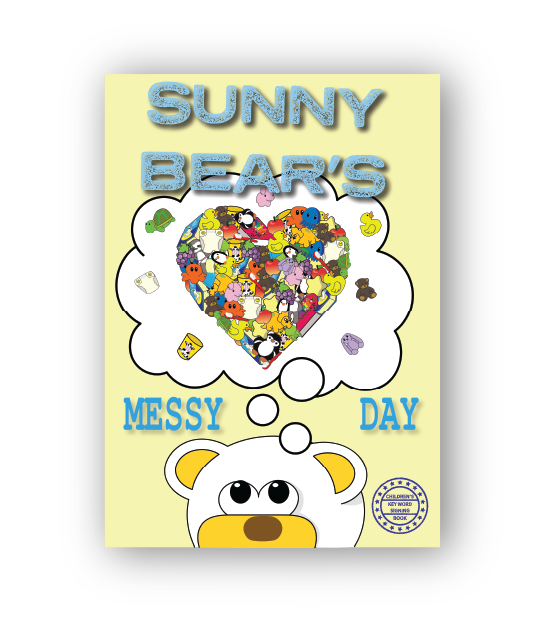
A4 Children’s Key Word Sign Story Book
This A4 key word sign children’s book, contains a bright simple story with associated key word sign on the other page. Once you are more familiar with the signs the back of the book contains key word signs for each key word in the children’s book.
Digital Resources
The children’s key word sign pack provides the kindergarten with membership access to the digital members area designed for early learning settings, the digital resources includes:
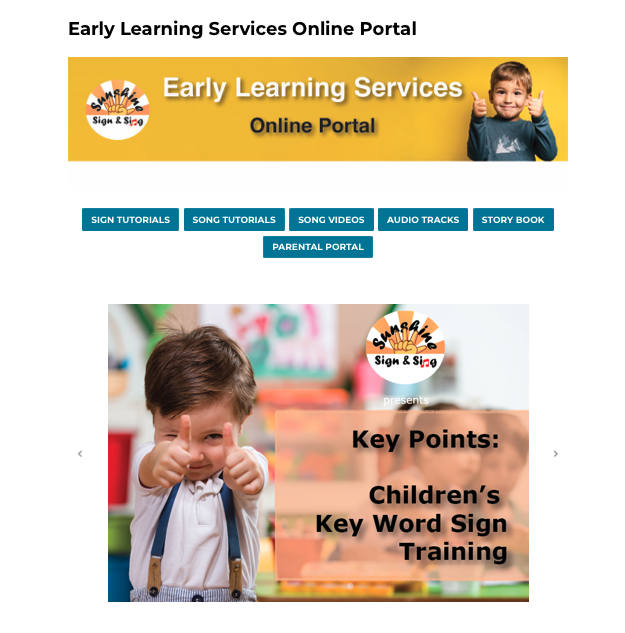
Information on Children’s Key Word Signing
This resource allows your Educator’s to refresh themselves on the information learnt in training, and provides them with the tools to champion key word sign at your Early Learning Setting.
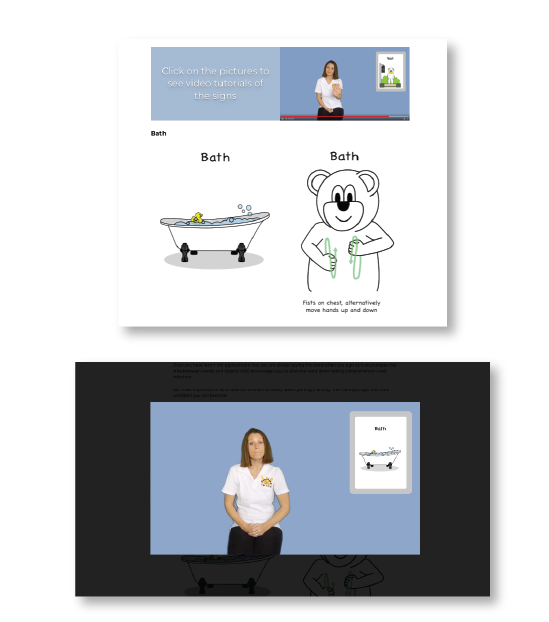
Children’s Key Word Sign Tutorials
The digital key word sign products contains key word sign tutorials for the everyday and lanyard flashcards. Just click on the images contained on the flashcards for a video tutorial of the key word sign.

Children’s Key Word Song Tutorials and Videos
This digital key word sign product provides you with separate videos of:
• Key Word Sign Tutorials;
• Sing and Sign along videos
For each of the 10 songs in the everyday sing and sign book.
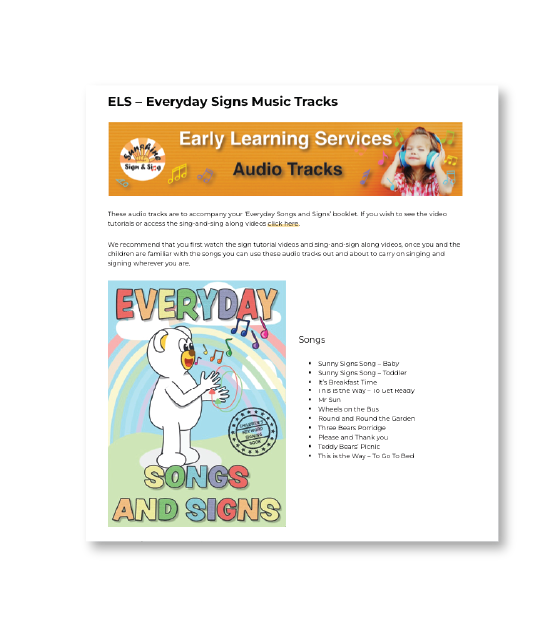
Music Tracks for the Everyday Song and Sing Booklet
The digital products gives you access to the MP3s of the songs in the book. Once you are your Early Learning Service are familiar with the songs and key word signs, you can use the MP3 to sing and sign along without the need for viewing the video resources.

Children’s Key Word Sign Book with Signs
The digital products gives you access to the Children’s Key Word Sign ‘Messy Day’ book being read with all key words being signed. It is a useful resource to gain familiarity with the signs before the Educator’s read the book to the children at your Early Learning Service.
Digital Products for Parents
The Children’s Key Word Sign pack includes separate digital resources for the parents and carers at your service. This resource has been designed to encourage parents and carers to take an active interest in Children’s Key Word Sign and encourage them to take steps to implement Children’s key word signing in their family setting.
While we accept it is often difficult to motivate parents and carers in such activities, it will, at the very minimum, give them access to the signs so they will be able to intepret any signs the children at your service may start to use at home.
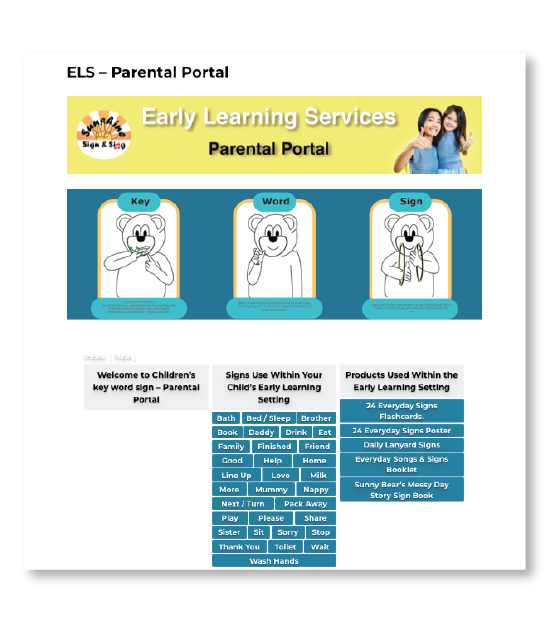
On the purchase of the CKWS pack, your Service will be provided a login for the parents and carers of your service. This login will give them access to the parental portal which includes:
• Information on Children’s key word sign
• Information on the benefits of Children’s key word sign
• Detailed instructions on how to do each of the key word signs used in your Service
• Details of resources used in your service and recommended resources in the home
• Free Printable Resources
Please click here to download the Kindy Uplift brochure.
We are also able to put together customised packages for individual services if required, including coming in and providing sessions for your children. Please contact us today to book in your first training or to discuss your Kindergarten’s needs.
Price List
In summary the Children’s Key Word Signing Pack for Early Learning Services includes the following:
• 2 x 1 hour 30 minute training sessions on Children’s Key Word Sign with sign tutorials
• Physical Products including Flashcards, Lanyard cards, Children’s Book and Song Book
• Digital Products for the Service including recap of training, sign tutorials, song tutorials, song videos, signed story book, MP3s of Songs
• Digital Products for the parents and carers including Information of Children’s key word sign, sign tutorials, free printable resources
• Follow Up Support at 3 and 6 months
The total for the Children’s Key Word Signing Pack is:
$1,300
Please note this does not include travel costs.
We are able to customise this training on request.
For more information or to book in your training please contact us today.
REFERENCES
1https://earlychildhood.qld.gov.au/funding-and-support/grants-tenders-and-funding/kindy-uplift-pilot
2 https://successforkidswithhearingloss.com/wp-content/uploads/2012/01/Signing-with-Babies-and-Children-Vollotton.pdf (accessed 13 September 2022)
3 Vallotton, C. D. (2009). Do infants influence their quality of care? Infants’ communicative gestures predict caregivers’ responsiveness. Infant Behavior and Development, 32, 351- 365; Kirk, E., Howlett, N., Pine, K. J., & Fletcher, B. C. (2013, April). To sign or not to sign? The impact of encouraging infants to gesture on infant language and maternal mind-mindedness. Child Development, 84(2), 574-590; Graham, S. A., & Kilbreath, C. S. (2007). It’s a sign of the kind: Gestures and words guide infants’ inductive inferences. Developmental Psychology, 43(5), 1111-1123; Vallotton, C. D. (2012a). Infant signs as intervention? Promoting symbolic gestures for preverbal children in low-income families supports responsive parent-child relationships. Early Childhood Research Quarterly, 37, 401-415.
4 Ramstad, Alaina. “Baby Sign’s Developmental Benefits.” (2019) p35
5 Ramstad, Alaina. “Baby Sign’s Developmental Benefits.” (2019). p33 re Kirk, Elizabeth, et al. “To sign or not to sign? The impact of encouraging infants to gesture on infant language and maternal mind‐mindedness.” Child development 84.2 (2013): 574-590.
6 Vallotton, Claire D. “Signs of emotion: What can preverbal children “say” about internal states?.” Infant Mental Health Journal: Official Publication of The World Association for Infant Mental Health 29.3 (2008): 234-258.
7 Karsten, Ashley E., et al. “Toddlers take emotion regulation into their own hands with infant signs.” YC Young Children72.1 (2017): 38-43.
8 Zeyl, Gabrielle. “The Effects of Gesture on Early Language Production.” (2019). re: Petitto, Laura Ann, et al. “Baby hands that move to the rhythm of language: hearing babies acquiring sign languages babble silently on the hands.” Cognition 93.1 (2004): 43-73.
9 Okyle C (2017) Show me a sign baby! School Library Journal NY https://www.slj.com/story/show-me-a-sign-baby-preverbal-kids-and-sign-language (accessed 15 September 2022)
10 Mueller, Vannesa, Amanda Sepulveda, and Sarai Rodriguez. “The effects of baby sign training on child development.” Early Child Development and Care 184.8 (2014): 1178-1191.
11https://sophia.stkate.edu/cgi/viewcontent.cgi?article=1191&context=maed [access 20 September 2022]
12 https://raisingchildren.net.au/babies/development/language-development/language-delay[access 20 September 2022]
13 Goodwyn, Susan W., Linda P. Acredolo, and Catherine A. Brown. “Impact of symbolic gesturing on early language development.” Journal of Nonverbal behavior 24.2 (2000): 81-103.
14 Seal, Brenda C., and Rory A. DePaolis. “Manual activity and onset of first words in babies exposed and not exposed to baby signing.” Sign Language Studies 14.4 (2014): 444-465.;
15 Seal, Brenda. “About baby signing.” The ASHA Leader 15.13 (2010): online-only.
16 Ramstad, Alaina. “Baby Sign’s Developmental Benefits.” (2019). p11 re Olson, Janet, and Elise Frank Masur. “Mothers respond differently to infants’ gestural versus nongestural communicative bids.” First Language 33.4 (2013): 372-387.
17 Cologon, Kathy, and Zinnia Mevawalla. “Increasing inclusion in early childhood: Key Word Sign as a communication partner intervention.” International journal of inclusive education 22.8 (2018): 902-920. page 2 re: Cress, Cynthia J., and Christine A. Marvin. “Common questions about AAC services in early intervention.” Augmentative and alternative communication 19.4 (2003): 254-272.; Dunst, Carl J., Diana Meter, and Deborah W. Hamby. “Influences of sign and oral language interventions on the speech and oral language production of young children with disabilities.” Center for Early Literacy Learning 4.4 (2011): 1-20.;Vandereet, Joke, et al. “The role of gestures in the transition from one‐to two‐word speech in a variety of children with intellectual disabilities.” International Journal of Language & Communication Disorders 46.6 (2011): 714-727.
18 Zeyl, Gabrielle. “The Effects of Gesture on Early Language Production.” (2019). p 12 re: Leech, Emily R. Baumann, and Cynthia J. Cress. “Indirect facilitation of speech in a late talking child by prompted production of picture symbols or signs.” Augmentative and Alternative Communication 27.1 (2011): 40-52.
19 Ramstad, Alaina. “Baby Sign’s Developmental Benefits.” (2019). p24 re: Mueller, Vannesa, Amanda Sepulveda, and Sarai Rodriguez. “The effects of baby sign training on child development.” Early Child Development and Care 184.8 (2014): 1178-1191.
20 Ramstad, Alaina. “Baby Sign’s Developmental Benefits.” (2019). p11 Brooks, R. & Meltzoff, A. N. (2008). Infant gaze following and pointing predict accelerated vocabulary growth through two years of age: a longitudinal, growth curve modeling study. Journal of Child Language 35, 207–20. and Walker, Dale, et al. “Language intervention research in early childhood care and education: A systematic survey of the literature.” Early Childhood Research Quarterly 50 (2020): 68-85.
21 Light, Janice, and David Mcnaughton. “Designing AAC research and intervention to improve outcomes for individuals with complex communication needs.” Augmentative and Alternative Communication 31.2 (2015): 85-96. as stated in Cologon, Kathy, and Zinnia Mevawalla. “Increasing inclusion in early childhood: Key Word Sign as a communication partner intervention.” International journal of inclusive education 22.8 (2018): 902-920. p4

